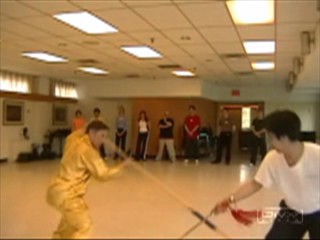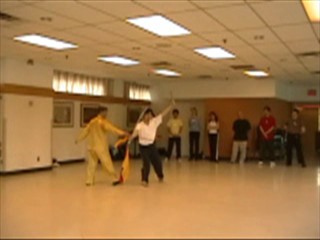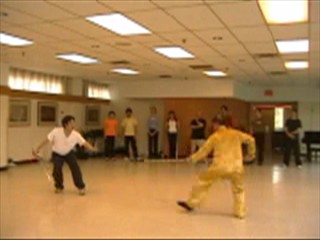SECRETS THAT ENHANCE COMBAT EFFICIENCY AND DAILY LIFE

Applying the sword to handle a pair of sabers
A single saber is formidable enough, double sabers are deadly. Why, then, many people use single sabers and not double sabers? It is because it needs a lot of skills to use double sabers well, otherwise the other saber becomes a liability instead of an asset. How would you use a sword to counter double sabers?
Grandmaster Wong's application of the sword was so skillful that someone asked whether he practiced the sword very often. He surprised everyone present when he said that the last time he used the sword against another weapon was at a public demonstration at the Science University of Malaysia more than 20 years ago.
This shows that once you have understood the basic principles and have developed the fundamental skills, you can apply them to different techniques in different situations. In other words, had Grandmaster Wong used another weapon, like an axe or even a stick, he would still be able to use it effectively. This is an example of the superiority of “smart training” over “water-buffalo training”.
The course participants were so impressed with the amazing application of the sword that one of them asked whether the sword would beat any other weapons. Grandmaster Wong explained that it was the skills of the combatant rather than the techniques of his weapon that decided victory.
Earlier he had used the sword to defeat the spear. That was because his skills were better than those of his opponent. Now they would reverse roles. Grandmaster Wong would use the spear against the sword. Although the swordsman knew the techniques against the spear, Grandmaster Wong was still able to defeat the opponent because of his (Grandmaster Wong's) superior skills.
That doesn't mean techniques are not important. We need techniques to practice as well as to apply our skills. This also doesn't mean that once you have the skills, you need not continue to practice. But regular practice is the hallmark of high-level skills.
Grandmaster Wong may not have practiced the specific sword techniques he used in the combat, but he maintains his regular Shaolin practice in general, which improves his fundamental skills like mental clarity, quick decision making, being relaxed and focused at the same time, energy flow, internal force, agility and fluidity of movement — the very skills that many other kungfu practitioners neglect or are unaware of, and the very skills that not only enhances combat efficiency but also our daily life. This is another great secret of “smart training”.
 Changing Hands and Circling Technique
Changing Hands and Circling Technique
Notice that Grandmaster Wong changes his front-holding hand from left to right, and vice versa. By using footwork and the circling technique, Grandmaster Wong is able to keep Sifu Chow at bay, which is crucial because in close combat the sword is much more advantageous than a spear.
He also employs the circling technique skillfully to break into the sword defence, but he compassionately slices the spearman's arm instead of piercing the spear into him.
Sword against Double Sabres -- Secrets that Enhance Combat Efficiency and Daily Life from Wong Kiew Kit on Vimeo.
-
1. The Dainty Chinese Sword against the Mighty Samurai Sword
2. The Master's Weapon against the Mother of Weapons
3. The Marvelous Sword against the King of Weapons
4. Traveling Dragon and Ferocious Tiger
5. How would You Defend against the Versatile Three-Sectional Staff
6. Secrets that Enhance Combat Efficiency and Daily Life
LINKS


